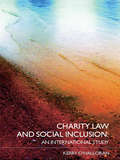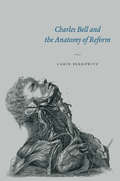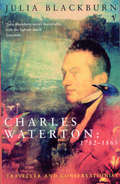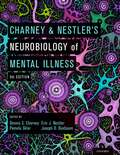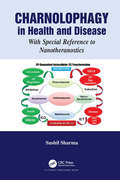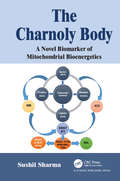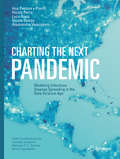- Table View
- List View
Charakterisierung des Wirkmechanismus von Selektiven Serotonin-Wiederaufnahme-Inhibitoren (BestMasters)
by Nina GeigerDie auftretenden Varianten von SARS-CoV-2 beschleunigen durch ihre höheren Übertragungsraten die globale COVID-19-Pandemie, wodurch dringend neue therapeutische Angriffsziele benötigt werden. Hierbei wurde die antivirale Wirkung von Fluoxetin - einem Antidepressivum - gegen SARS-CoV-2 entdeckt. Mithilfe biochemischer und bildgebenden Methoden wurde der antivirale Wirkmechanismus von Fluoxetin näher analysiert und die saure Ceramidase als SARS-CoV-2 Wirtsfaktor charakterisiert. Veröffentlichte Studien zeigten, dass auch Aspirin eine antivirale Wirkung gegen Erkältungsviren, wie Rhinoviren und Influenzaviren zeigt. Diese antivirale Wirkung wurde in Bezug auf SARS-CoV-2 in Zellkultur und einem patienten-nahen 3D-Infektionsmodell untersucht und bestätigt. Um die Pathologie einer SARS-CoV-2-Infektion zu verstehen, wurde der Eintrittsweg des Virus in das Gehirn untersucht. Im Gegensatz zu anderen Viren überwindet SARS-CoV-2 die Blut-Hirnschranke ohne T-Zellen oder Makrophagen. Ebenso wurde der Einbau eines lipophilen Fluoreszenzfarbstoffs in die Virusmembran etabliert, womit die direkte Markierung verschiedener Viren trotz ihrer unterschiedlicher Membranzusammensetzung möglich ist. Mit superauflösender Mikroskopie (SIM) wurde der virale Eintritt verschiedener umhüllter Viren visualisiert.
Charity Law and Social Inclusion: An International Study
by Kerry O'HalloranProfiling national and international social inclusion agendas, Charity Law and Social Inclusion examines the fit between the charity law framework and the needs of the socially marginalized in some leading common law nations: the US, England and Wales, Ireland, Australia, New Zealand and Canada. It: examines the concepts of philanthropy, inclusion, alienation and justice considers the competing claims of philanthropy, legal rights and politics as appropriate methods of pursuing social justice explains how weaknesses in charity law obstructs philanthropic intervention makes recommendations for changes to the legal framework governing philanthropy. O’Halloran argues that our common charity law heritage must be updated and co-ordinated to be capable of addressing social inclusion in the twenty-first century. This book is of interest to academics and students working and sudying in the areas of social policy, sociology and law, as well as professionals in community and voluntary work.
Charity Law and Social Inclusion: An International Study
by Kerry O'HalloranProfiling national and international social inclusion agendas, Charity Law and Social Inclusion examines the fit between the charity law framework and the needs of the socially marginalized in some leading common law nations: the US, England and Wales, Ireland, Australia, New Zealand and Canada. It: examines the concepts of philanthropy, inclusion, alienation and justice considers the competing claims of philanthropy, legal rights and politics as appropriate methods of pursuing social justice explains how weaknesses in charity law obstructs philanthropic intervention makes recommendations for changes to the legal framework governing philanthropy. O’Halloran argues that our common charity law heritage must be updated and co-ordinated to be capable of addressing social inclusion in the twenty-first century. This book is of interest to academics and students working and sudying in the areas of social policy, sociology and law, as well as professionals in community and voluntary work.
Charlatans (A\medical Thriller Ser.)
by Robin CookCharlatans is an explosive thriller from New York Times bestselling author and master of the medical thriller Robin Cook.Noah Rothauser is the new super chief resident at the state-of-the-art Boston Memorial Hospital. Taking on such a prestigious job is a dream come true, but the pressures of the role become all too clear when a seemingly routine operation ends in disaster. With potential foul play suspected it falls to Noah to investigate what happened.Questioning those involved uncovers bitter feuds within the team when the egotistical Dr. William Mason is quick to blame staff anesthesiologist Dr. Ava London for the tragic outcome. However Dr. London, along with the nursing staff, point the finger at the surgeon.When two more unexpected deaths occur, Noah is forced to look closer at the impressively competent, charming, yet mysterious Dr. London. With his own job and integrity coming into jeopardy, Noah must decide which doctor is at fault and who he can believe – before any more lives are lost . . .
Charles Bell and the Anatomy of Reform
by Carin BerkowitzSir Charles Bell (1774–1842) was a medical reformer in a great age of reform—an occasional and reluctant vivisectionist, a theistic popularizer of natural science, a Fellow of the Royal Society, a surgeon, an artist, and a teacher. He was among the last of a generation of medical men who strove to fashion a particularly British science of medicine; who formed their careers, their research, and their publications through the private classrooms of nineteenth-century London; and whose politics were shaped by the exigencies of developing a living through patronage in a time when careers in medical science simply did not exist. A decade after Bell’s death, that world was gone, replaced by professionalism, standardized education, and regular career paths. In Charles Bell and the Anatomy of Reform, Carin Berkowitz takes readers into Bell’s world, helping us understand the life of medicine before the modern separation of classroom, laboratory, and clinic. Through Bell’s story, we witness the age when modern medical science, with its practical universities, set curricula, and medical professionals, was born.
Charles Bell and the Anatomy of Reform
by Carin BerkowitzSir Charles Bell (1774–1842) was a medical reformer in a great age of reform—an occasional and reluctant vivisectionist, a theistic popularizer of natural science, a Fellow of the Royal Society, a surgeon, an artist, and a teacher. He was among the last of a generation of medical men who strove to fashion a particularly British science of medicine; who formed their careers, their research, and their publications through the private classrooms of nineteenth-century London; and whose politics were shaped by the exigencies of developing a living through patronage in a time when careers in medical science simply did not exist. A decade after Bell’s death, that world was gone, replaced by professionalism, standardized education, and regular career paths. In Charles Bell and the Anatomy of Reform, Carin Berkowitz takes readers into Bell’s world, helping us understand the life of medicine before the modern separation of classroom, laboratory, and clinic. Through Bell’s story, we witness the age when modern medical science, with its practical universities, set curricula, and medical professionals, was born.
Charles Bell and the Anatomy of Reform
by Carin BerkowitzSir Charles Bell (1774–1842) was a medical reformer in a great age of reform—an occasional and reluctant vivisectionist, a theistic popularizer of natural science, a Fellow of the Royal Society, a surgeon, an artist, and a teacher. He was among the last of a generation of medical men who strove to fashion a particularly British science of medicine; who formed their careers, their research, and their publications through the private classrooms of nineteenth-century London; and whose politics were shaped by the exigencies of developing a living through patronage in a time when careers in medical science simply did not exist. A decade after Bell’s death, that world was gone, replaced by professionalism, standardized education, and regular career paths. In Charles Bell and the Anatomy of Reform, Carin Berkowitz takes readers into Bell’s world, helping us understand the life of medicine before the modern separation of classroom, laboratory, and clinic. Through Bell’s story, we witness the age when modern medical science, with its practical universities, set curricula, and medical professionals, was born.
Charles Bell and the Anatomy of Reform
by Carin BerkowitzSir Charles Bell (1774–1842) was a medical reformer in a great age of reform—an occasional and reluctant vivisectionist, a theistic popularizer of natural science, a Fellow of the Royal Society, a surgeon, an artist, and a teacher. He was among the last of a generation of medical men who strove to fashion a particularly British science of medicine; who formed their careers, their research, and their publications through the private classrooms of nineteenth-century London; and whose politics were shaped by the exigencies of developing a living through patronage in a time when careers in medical science simply did not exist. A decade after Bell’s death, that world was gone, replaced by professionalism, standardized education, and regular career paths. In Charles Bell and the Anatomy of Reform, Carin Berkowitz takes readers into Bell’s world, helping us understand the life of medicine before the modern separation of classroom, laboratory, and clinic. Through Bell’s story, we witness the age when modern medical science, with its practical universities, set curricula, and medical professionals, was born.
Charles Bonnet and the Order of the Known (Studies in the History of Modern Science #11)
by L. AndersonCharles Bonnet began his career as a naturalist, from an early age establishing a reputation as a careful observer. It is for those youthful observations, as well as for some suggestive speculations proposed relative to this field, that he is best remembered in English-speaking countries: regarding the taxonomic de mands of natural history he refurbished the idea of a chain of beings; regarding the question of generation he marshaled evidence in support of preforma tion theory; and regarding the analysis of the physiology of the nervous system he advanced a theory that individual nerve fibers receive and retain specific sensations. Following his loss of eyesight in his mid-twenties Bonnet entered a more reflective period, turning to philosophy and pondering the nature of human understanding - considerations he had formerly disdained, but that now seemed a natural outgrowth of his reflections on nature. This essay focuses on the philosophical and psychological works of the later period, the period in which he wrote all his major books. By giving these writings a broader exposure it has been one of my hopes that Bonnet's audience would also be broadened, releasing him, so to speak, from the charge of historians of science so that he might fmd his way, in general books on the "Enlightenment", from scattered footnotes into the texts themselves.
Charles-Edouard Brown-Séquard: The Biography of a Tormented Genius
by Louis-Cyril CelestinGenius and dilettantism often go hand in hand. Nowhere is this truer than in the life of Charles-Edouard Brown-Séquard, the bilingual physician and neurologist who succeeded Claude Bernard as the Chair of Experimental Medicine at the College de France in Paris after having practiced in Paris, London and in the USA, especially in Harvard.For most men, making one discovery of global importance would have sufficed to satisfy their curiosity and self-image. Not so Brown-Séquard. His explanation of the neurological disparity following the hemi-section of the spinal cord was a unique achievement that added his name to the syndrome and made him immortal. Yet, the demons of his mind tormented him in his endless search for medical truths and drove him to explore other phenomena, seeking to explain and remedy them.This unique biography shows for the first time the conflict between his professional and personal life, and should appeal to all students of medical history and psychology.
Charles Waterton 1782-1865: Traveller and Conservationist
by Julia BlackburnCharles Waterton was the first conservationist who fought to protect wild nature against the destruction and pollution of Victorian industrialisation. During his lifetime he was famous for his eccentricities, but also for his achievements and his opinions. A Yorkshire landowner, he turned his park into a sanctuary for animals and birds. As an explorer he learned to survive in the tropical rain forests of South America without a gun or the society of other white men. He was an authority on the poisons used by South American Indians and a taxidermist of note. The huge public that read his books included Dickens, Darwin and Roosevelt. Since his death the memory of Waterton's personal eccenticities has flourished, while the originality of his ideas and work has often suffered. Using his surviving papers, Julia Blackburn has redressed the balance in a biogr aphy that restores Waterton to his place as the first conservationist of the modern age.
Charlie the Kitten Who Saved A Life: The Kitten Who Saved a Life
by Sheila NortonHeartwarming and lovable, Charlie will squirm his way into your heart. Perfect for fans of A Streetcat Named Bob and Alfie the Doorstep Cat.But what could I do? I was just a little cat and nobody ever listened to me. I made a promise to myself that I’d do everything I possibly could to save her, whatever the danger to me, and no matter how many lives I lost in the process...Charlie the kitten would do anything for his human. Having just recovered from a debilitating illness, eleven-year-old Caroline isn’t feeling her best, and the arrival of a new baby only makes her feel even more left out.So when Caroline decides to run away, Charlie follows, vowing to protect her at all costs. But for such a little kitten, it’s a big and scary world outside the comfort of the cottage – how far will he go to save his greatest friend?
Charlotte Brontë and Contagion: Myths, Memes, and the Politics of Infection (Palgrave Studies in Literature, Science and Medicine)
by Jo WaughThis book argues for the significance of contagious disease in critical and biographical assessment of Charlotte Brontë’s work. Waugh argues that contagion, infection, and quarantining strategies are central themes in Jane Eyre (1847), Shirley (1849), and Villette (1853). This book establishes the ways in which Charlotte Brontë was closely engaged with the political and social contexts in which she wrote, extending this to the representation and metaphorical import of illness in Brontë’s novels. Waugh also posits that although miasmatic theories are often assumed to have been entirely in the ascendant in the late 1840s, the relationship between miasma and contagion was a complex one and contagion in fact remained a crucial way for Charlotte Brontë to represent disease itself, as well as to explore the relationships between the individual and social, political, and cultural contexts. Contagion and its metaphors are central to Charlotte Brontë’s construction of subjectivity and of the responsibilities of the individual and the group.
Charney & Nestler's Neurobiology of Mental Illness
In the years following publication of the DSM-5®, the field of psychiatry has seen vigorous debate between the DSM's more traditional, diagnosis-oriented approach and the NIMH's more biological, dimension-based RDoC (research domain criteria) approach. Charney & Nestler's Neurobiology of Mental Illness is an authoritative foundation for translating information from the laboratory to clinical treatment, and its fifth edition extends beyond this reference function to acknowledge and examine the controversies, different camps, and thoughts on the future of psychiatric diagnosis. In this wider context, this book provides information from numerous levels of analysis, including molecular biology and genetics, cellular physiology, neuroanatomy, neuropharmacology, epidemiology, and behavior. Sections and chapters are edited and authored by experts at the top of their fields. No other book distills the basic science and underpinnings of mental disorders-and highlights practical clinical significance-to the scope and breadth of this classic text. In this edition, Section 1, which reviews the methods used to examine the biological basis of mental illness in animal and cell models and in humans, has been expanded to reflect critically important technical advances in complex genetics (including powerful sequencing technologies and related bioinformatics), epigenetics, stem cell biology, optogenetics, neural circuit functioning, cognitive neuroscience, and brain imaging. This range of established and emerging methodologies offer groundbreaking advances in our ability to study the brain as well as unique opportunities for the translation of preclinical and clinical research into badly needed breakthroughs in our therapeutic toolkit. Sections 2 through 7 cover the neurobiology and genetics of major psychiatric disorders: psychoses (including bipolar disorder), mood disorders, anxiety disorders, substance use disorders, dementias, and disorders of childhood onset. Also covered within these sections is a summary of current therapeutic approaches for these illnesses as well as the ways in which research advances are now guiding the search for new treatments. Each of these parts has been augmented in several different areas as a reflection of research progress. The last section, Section 8, reconfigured in this new edition, now focuses on diagnostic schemes for mental illness. This includes an overview of the unique challenges that remain in diagnosing these disorders given our still limited knowledge of disease etiology and pathophysiology. The section then provides reviews of DSM-5®, which forms the basis of psychiatric diagnosis in the United States for all clinical work, and of RDoC, which provides an alternative perspective on diagnosis in heavy use in the research community. Also included are chapters on future efforts toward precision and computational psychiatry, which promise to someday align diagnosis with underlying biological abnormalities.
Charnley Low-Frictional Torque Arthroplasty of the Hip: Practice and Results
by B.M. Wroblewski Paul D. Siney Patricia A. FlemingThis book reviews the principles and concepts underlying Professor Sir John Charnley’s original work Low Friction Arthroplasty of the Hip: Theory and Practice (Springer, 1979) in the light of more extensive clinical experience with results, incidence and indications for revisions highlighted throughout. The studies, combined with the examination of explanted components carried out with the backing of Universities, indicate the avenues for further research and the development and introduction of new ideas into clinical practice. The time span (1962 – 2015) involved has allowed a number of these very long-term studies not only to be brought to conclusion, but has given the benefit of their clinical application with meaningful results. This is not a sudden diversion into new and speculative areas of hip replacement surgery. It is a carefully collected, documented and executed work of the evolution of the Charnley low-frictional torque arthroplasty of the hip based on sound principles, supported by long-term studies with benefits derived.
Charnolophagy in Health and Disease: With Special Reference to Nanotheranostics
by Sushil SharmaThis book introduces charnolophagy (CP) as energy-driven, lysosomal-dependent mitochondrial inclusion-specific pleomorphic Charnoly body (CB) autophagy (ATG) involving free radical-induced Ca2+ dyshomeostasis, ΔΨ collapse, and ATP depletion in congenital diseases, pressure ulcers, metabolic diseases, hepatic diseases, diabetes, obesity, inflammatory diseases, musculoskeletal diseases, sarcopenia, cachexia, respiratory diseases, gastrointestinal diseases, hyperlipidemia, skin and hair diseases, pulmonary diseases, cardiovascular diseases, renal diseases, sepsis-induced multi-organ failure, reproductive diseases, inflammatory diseases, ophthalmic diseases, neurodegenerative diseases, drug addiction, aging, microbial (including COVID-19) infections, and belligerent malignancies implicated in early morbidity and mortality and disease-specific spatiotemporal, targeted, safe, and effective evidence-based personalized theranostic charnolopharmacotherapeutics to cure them. Basic DRESS and GELS principles, nanoparticles to cure chronic multidrug-resistant (MDR) diseases, antioxidants as free radical scavengers, CB antagonists, CP regulators, and CS stabilizers to curb CB molecular pathogenesis (CBMP) are described for better quality of life and longevity. Specific guidelines for environmental protection and preservation of zoological and botanical species at the verge of extinction, Triple "I" Hypothesis for mitochondrial quality control, and transcriptional regulation of CSexR and CSendoR to cure chronic diseases are presented. Novel CP index is introduced to evaluate MDR malignancies and other chronic diseases. WHO, CDC, FDA, NIH, policy planners, cosmetologists, trichologists, players, athletes, dancers, wrestlers, equestrians, young women, aging population, toxicologists, environmental protectionists, pharmaceutical industry, biomedical scientists, researchers, medical students, physicians, nurses, paramedical professionals, and global audience will be interested in this interesting book to prevent pandemics and raise healthcare awareness.
Charnolophagy in Health and Disease: With Special Reference to Nanotheranostics
by Sushil SharmaThis book introduces charnolophagy (CP) as energy-driven, lysosomal-dependent mitochondrial inclusion-specific pleomorphic Charnoly body (CB) autophagy (ATG) involving free radical-induced Ca2+ dyshomeostasis, ΔΨ collapse, and ATP depletion in congenital diseases, pressure ulcers, metabolic diseases, hepatic diseases, diabetes, obesity, inflammatory diseases, musculoskeletal diseases, sarcopenia, cachexia, respiratory diseases, gastrointestinal diseases, hyperlipidemia, skin and hair diseases, pulmonary diseases, cardiovascular diseases, renal diseases, sepsis-induced multi-organ failure, reproductive diseases, inflammatory diseases, ophthalmic diseases, neurodegenerative diseases, drug addiction, aging, microbial (including COVID-19) infections, and belligerent malignancies implicated in early morbidity and mortality and disease-specific spatiotemporal, targeted, safe, and effective evidence-based personalized theranostic charnolopharmacotherapeutics to cure them. Basic DRESS and GELS principles, nanoparticles to cure chronic multidrug-resistant (MDR) diseases, antioxidants as free radical scavengers, CB antagonists, CP regulators, and CS stabilizers to curb CB molecular pathogenesis (CBMP) are described for better quality of life and longevity. Specific guidelines for environmental protection and preservation of zoological and botanical species at the verge of extinction, Triple "I" Hypothesis for mitochondrial quality control, and transcriptional regulation of CSexR and CSendoR to cure chronic diseases are presented. Novel CP index is introduced to evaluate MDR malignancies and other chronic diseases. WHO, CDC, FDA, NIH, policy planners, cosmetologists, trichologists, players, athletes, dancers, wrestlers, equestrians, young women, aging population, toxicologists, environmental protectionists, pharmaceutical industry, biomedical scientists, researchers, medical students, physicians, nurses, paramedical professionals, and global audience will be interested in this interesting book to prevent pandemics and raise healthcare awareness.
The Charnoly Body: A Novel Biomarker of Mitochondrial Bioenergetics
by Sushil SharmaDiversified physicochemical injuries trigger Charnoly body (CB) formation as pleomorphic, electron-dense, multi-lamellar stacks of nonfunctional mitochondrial membranes in the most vulnerable cell. Free radicals induce downregulation of mitochondrial DNA, microRNA, AgNOR, and epigenetics to trigger CB molecular pathogenesis. CB is eliminated by energy (ATP)-driven lysosome-dependent charnolophagy as a basic molecular mechanism of intracellular detoxification to prevent acute and chronic diseases. Accumulation of CB at the junction of axon hillock and charnolosome (CS) at the synapses causes cognitive impairments; whereas, nonspecific induction of CB causes GIT stress, myelosuppression, alopecia, neurotoxicity, cardiotoxicity, and infertility in multidrug-resistant malignancies. Hence, stem cell-specific CB, charnolophagy, and CS agonists/antagonists are introduced as novel charnolopharmacotherapeutics for the successful treatment of cardiovascular diseases, neurodegenerative diseases, infectious diseases, drug addiction, and cancer. Nanoparticles to improve drug delivery, CS exocytosis, and disease-specific spatiotemporal charnolosomics employing correlative and combinatorial bioinformatics boost mitochondrial bioenergetics through balanced diet, exercise, and antioxidants. The book will be of interest to medical scientists and practitioners.
The Charnoly Body: A Novel Biomarker of Mitochondrial Bioenergetics
by Sushil SharmaDiversified physicochemical injuries trigger Charnoly body (CB) formation as pleomorphic, electron-dense, multi-lamellar stacks of nonfunctional mitochondrial membranes in the most vulnerable cell. Free radicals induce downregulation of mitochondrial DNA, microRNA, AgNOR, and epigenetics to trigger CB molecular pathogenesis. CB is eliminated by energy (ATP)-driven lysosome-dependent charnolophagy as a basic molecular mechanism of intracellular detoxification to prevent acute and chronic diseases. Accumulation of CB at the junction of axon hillock and charnolosome (CS) at the synapses causes cognitive impairments; whereas, nonspecific induction of CB causes GIT stress, myelosuppression, alopecia, neurotoxicity, cardiotoxicity, and infertility in multidrug-resistant malignancies. Hence, stem cell-specific CB, charnolophagy, and CS agonists/antagonists are introduced as novel charnolopharmacotherapeutics for the successful treatment of cardiovascular diseases, neurodegenerative diseases, infectious diseases, drug addiction, and cancer. Nanoparticles to improve drug delivery, CS exocytosis, and disease-specific spatiotemporal charnolosomics employing correlative and combinatorial bioinformatics boost mitochondrial bioenergetics through balanced diet, exercise, and antioxidants. The book will be of interest to medical scientists and practitioners.
Charting Spiritual Care: The Emerging Role of Chaplaincy Records in Global Health Care
by Simon Peng-Keller David NeuholdThis open access volume is the first academic book on the controversial issue of including spiritual care in integrated electronic medical records (EMR). Based on an international study group comprising researchers from Europe (The Netherlands, Belgium and Switzerland), the United States, Canada, and Australia, this edited collection provides an overview of different charting practices and experiences in various countries and healthcare contexts. Encompassing case studies and analyses of theological, ethical, legal, healthcare policy, and practical issues, the volume is a groundbreaking reference for future discussion, research, and strategic planning for inter- or multi-faith healthcare chaplains and other spiritual care providers involved in the new field of documenting spiritual care in EMR. Topics explored among the chapters include: Spiritual Care Charting/Documenting/Recording/AssessmentCharting Spiritual Care: Psychiatric and Psychotherapeutic Aspects Palliative Chaplain Spiritual Assessment Progress Notes Charting Spiritual Care: Ethical Perspectives Charting Spiritual Care in Digital Health: Analyses and Perspectives Charting Spiritual Care: The Emerging Role of Chaplaincy Records in Global Health Care is an essential resource for researchers in interprofessional spiritual care and healthcare chaplaincy, healthcare chaplains and other spiritual caregivers (nurses, physicians, psychologists, etc.), practical theologians and health ethicists, and church and denominational representatives.
Charting the Impacts of University-Child Welfare Collaboration
by Katharine Briar-Lawson Joan Levy ZlotnikTrain-and keep-a child welfare workforce that will make a difference! Charting the Impacts of University-Child Welfare Collaboration addresses the challenges of implementing workforce development initiatives designed to recruit students into the public child welfare field. Edited by Dr. Katharine Briar-Lawson, Dean of the School of Social Welfare at the University at Albany in New York, and Dr. Joan Levy Zlotnik, PhD, ACSW, Executive Director of the Institute for the Advancement of Social Work Research, the book reflects the ongoing effort to counteract the "de-professionalization" phase of the 1970s and 80s that has impeded child welfare service delivery. A panel of practitioners, educators, and researchers focus on training and administrative funding, collaborative practices, delivery of educational content, preparation challenges faced by educators, and future challenges. Charting the Impacts of University-Child Welfare Collaboration examines strategies for specialized educational efforts supported by federal Title IV-E and Title IV-B Section 426 funding. The book addresses the process for preparing and maintaining a professional workforce, including collaborations between social work educators and their partnering public child welfare agencies that have led to experimental and innovative changes in practice and curricula. Topics include: determining a graduate's emotion capacity for child welfare service delivering educational content in human behavior in the social environment courses determining the return on funding investments using cognitive-affective models of student development using design teams to promote practice innovations, systems change, and cross-systems change and an examination of the California Collaboration, a competency-based child welfare curriculum project for MSW candidates. Charting the Impacts of University-Child Welfare Collaboration is an essential resource for continuing the campaign for workforce development and re-professionalism in child welfare practice. The book is invaluable for educators and professionals working to develop reliable, relevant, and competent staffing.
Charting the Impacts of University-Child Welfare Collaboration
by Katharine Briar-Lawson Joan Levy ZlotnikTrain-and keep-a child welfare workforce that will make a difference! Charting the Impacts of University-Child Welfare Collaboration addresses the challenges of implementing workforce development initiatives designed to recruit students into the public child welfare field. Edited by Dr. Katharine Briar-Lawson, Dean of the School of Social Welfare at the University at Albany in New York, and Dr. Joan Levy Zlotnik, PhD, ACSW, Executive Director of the Institute for the Advancement of Social Work Research, the book reflects the ongoing effort to counteract the "de-professionalization" phase of the 1970s and 80s that has impeded child welfare service delivery. A panel of practitioners, educators, and researchers focus on training and administrative funding, collaborative practices, delivery of educational content, preparation challenges faced by educators, and future challenges. Charting the Impacts of University-Child Welfare Collaboration examines strategies for specialized educational efforts supported by federal Title IV-E and Title IV-B Section 426 funding. The book addresses the process for preparing and maintaining a professional workforce, including collaborations between social work educators and their partnering public child welfare agencies that have led to experimental and innovative changes in practice and curricula. Topics include: determining a graduate's emotion capacity for child welfare service delivering educational content in human behavior in the social environment courses determining the return on funding investments using cognitive-affective models of student development using design teams to promote practice innovations, systems change, and cross-systems change and an examination of the California Collaboration, a competency-based child welfare curriculum project for MSW candidates. Charting the Impacts of University-Child Welfare Collaboration is an essential resource for continuing the campaign for workforce development and re-professionalism in child welfare practice. The book is invaluable for educators and professionals working to develop reliable, relevant, and competent staffing.
Charting the Next Pandemic: Modeling Infectious Disease Spreading In The Data Science Age
by Alessandro Vespignani Luca Rossi Bruno Gonçalves Nicola Perra Ana Pastore y Piontti Nicole Samay Corrado Gioannini Marcelo F. GomesThis book provides an introduction to the computational and complex systems modeling of the global spreading of infectious diseases. The latest developments in the area of contagion processes modeling are discussed, and readers are exposed to real world examples of data-model integration impacting the decision-making process. Recent advances in computational science and the increasing availability of real-world data are making it possible to develop realistic scenarios and real-time forecasts of the global spreading of emerging health threats.The first part of the book guides the reader through sophisticated complex systems modeling techniques with a non-technical and visual approach, explaining and illustrating the construction of the modern framework used to project the spread of pandemics and epidemics. Models can be used to transform data to knowledge that is intuitively communicated by powerful infographics and for this reason, the second part of the book focuses on a set of charts that illustrate possible scenarios of future pandemics. The visual atlas contained allows the reader to identify commonalities and patterns in emerging health threats, as well as explore the wide range of models and data that can be used by policy makers to anticipate trends, evaluate risks and eventually manage future events.Charting the Next Pandemic puts the reader in the position to explore different pandemic scenarios and to understand the potential impact of available containment and prevention strategies. This book emphasizes the importance of a global perspective in the assessment of emerging health threats and captures the possible evolution of the next pandemic, while at the same time providing the intelligence needed to fight it. The text will appeal to a wide range of audiences with diverse technical backgrounds.
Charts & Graphs: Guidelines for the visual presentation of statistical data in the life sciences
by Doig SimmondsThis book has been compiled by professional members interesting journey. If this initial and fleeting moment, of the Institute of Medical and Biological Illustration. It in which the eye 'questions' the object is lost the data is intended as a guide for persons preparing charts and or information may be shunned for ever as being graphs for publication or teaching slides by listing and boring. Good design aids the selection of a prime point describing some of the major limitations which must be and assists the journey all the way to its conclusion. observed if the visual presentation of data is to be Even tables can be made interesting by applying some legible and easily comprehended. The application of of the principles described in this book. standards to the production of medical and biological graphics is long overdue and it is hoped that this book An illegible or badly designed illustration antagonizes will not only help the amateur who is preparing his or the reader or viewer and can thus be a serious her own illustrations, but that it will also serve as a disadvantage to its author. A bad reputation is always reminder to the professional illustrator. We hope also hard to lose. It is most important to realize right from the that the publication of these standards might en start that legibility in one form does not automatically courage the editors of journals to standardize on their imply legibility in another.


